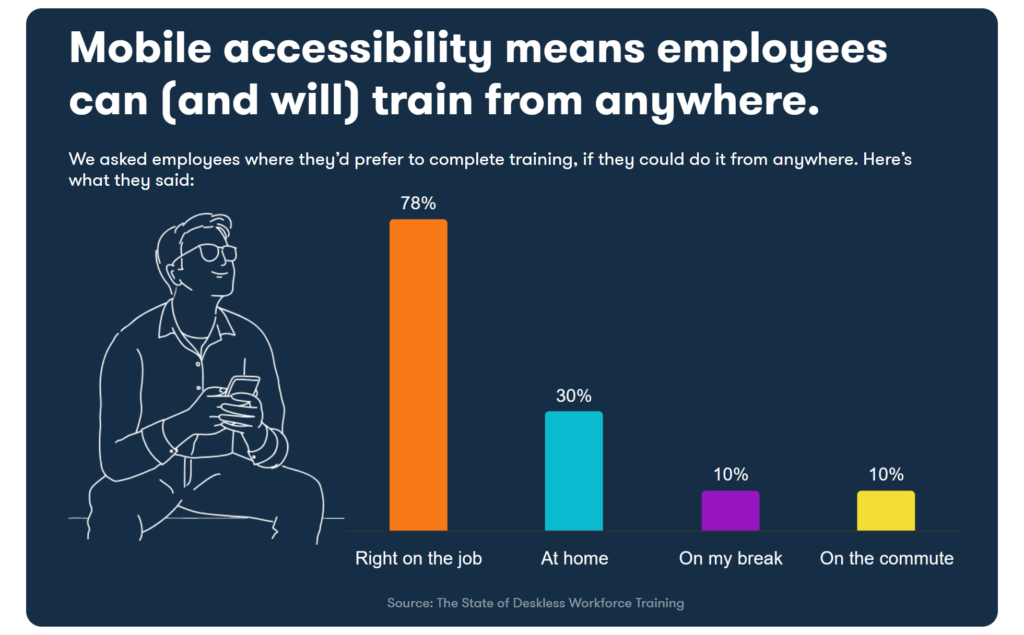Learning and development (L&D) play a crucial role in professional growth and skill enhancement within organizations. While learning and development programs have traditionally focused on office employees, the significance of providing similar opportunities to mobile and deskless employees cannot be overstated.
Organizations can ensure fairness and empower their workforce by closing this gap and offering comprehensive learning and development initiatives for deskless employees.
Read on as we will explore the concept of learning and development, shed light on the existing gap for deskless workers, discuss the importance of training decentralized workforces, and provide guidance on designing an L&D strategy tailored to them.
What is learning and development?
Learning and development is the process of gaining knowledge, skills, and abilities to improve performance and personal growth. In a work setting, it focuses on helping employees develop and become better at their jobs, leading to increased productivity.
Learning involves acquiring knowledge, skills, and attitudes, while development focuses on expanding and deepening understanding in alignment with personal growth objectives. While this can take place in any part of life, here we’ll focus specifically on L&D in businesses with mobile employees.
What is L&D in business?
L&D in business means creating programs that match the goals of the company. It helps employees learn new skills, adapt and grow with the industry, and enhance their job performance. However, deskless employees often face a significant difference in accessing learning development opportunities compared to those in an office.
The main objective is to improve the outcomes of individuals and groups. It involves sharing knowledge and insights to enhance their work performance and cultivate attitudes that improve overall performance.
This process should be ongoing throughout the life of your business, and with each employee. A solid L&D program will improve the health of your business. The benefits include a well-developed staff, improved outcomes, and higher employee retention.
The learning & development gap— how field employees have been left out
Traditional office employees, a dwindling minority, make up only 20% of the global workforce. The remaining 80% are deskless workers who operate on the go or in the field. Training approaches for most of the current workforce haven’t caught up with this change in demographics.
Inflation, increased costs, and labor shortages have impacted all industries. Companies employing deskless workers, particularly in construction, manufacturing, shipping, and distribution, have been severely impacted by the labor shortage.
Historically, employees who work in mobile industries or have deskless jobs have yet to be addressed when it comes to learning and development initiatives. This has led to a shortage of skilled workers in these industries.
A recent TalentCards survey revealed that 73% of shipping/distribution companies, and 77% of transportation/warehousing companies are facing difficulties in finding qualified workers. This shortage is caused by high demand, a lack of skilled labor, and challenges in retaining employees.
Further, it’s reported that 38% and 45% of new hires, respectively in the aforementioned industries, are lacking the necessary skills for the job at the time they’re hired.
Humane is a company that was created to address the gap between education tech and logistics tech. Its founder, Aurélien Jacomy, personally witnessed the lack of essential training in the shipping and distribution industry.
Providing basic training to a new hire isn’t enough. Humane understands the importance of delivering easily accessible and impactful training. Having an engaging and easy-to-use platform is a must.
“Usually what these employees receive is just basic training about what they should do in their day to day. There is no prospect for them to grow in their careers. Our question was, Can we create something that will really interest blue-collar workers, or will they complete training just because they’re forced to? And, ultimately, can we cause a significant positive impact on the company’s overall operational performance?”
—Aurélien Jacomy, Founder of Humane
By partnering with TalentCards, a mobile training platform, Humane successfully bridges the learning gap. Their end users include deskless workers such as truck drivers who are often on the road and distant from a central office, and they reported feeling excluded in the past. However, with customized training that is concise and focused, these employees feel empowered and valued. With training that is, “short, direct, and to the point” they are getting just what they need.
Your business can’t afford to overlook learning and development for your deskless workforce. By making it a priority you’ll stand out in a crowded space while attracting and retaining top talent.
Why do learning and training development matter?
No matter the industry, company size, or business model, L&D is a key component of every business. A severe lack of skilled new hires (or any new hires, for that matter) makes this a top priority. There are countless reasons why learning and training development matter:
Attracting and retaining top talent
When job searching, the vast majority put development and growth opportunities at the top of their wish list. According to a LinkedIn Workplace Learning Report, a staggering 94% of employees reported they would stay longer at a company that invested in their careers. With hiring deskless workers already a challenge, employee retention is more important than ever.
Improving productivity
Upon hiring an employee, it’s critical to develop them. Development happens when learning is in a continuous cycle. By making this a part of your company culture, staff will work to keep up with each other, thus improving their productivity, and a natural boost in efficiency.
Increasing profitability
Retraining and upskilling are typically more cost-effective than hiring someone new. Thirty-nine percent of managers responsible for onboarding deskless employees stated that the cost per employee is between $1,000 – $5,000. Another 23% reported that the cost per employee exceeds $5,000. Investing in developing current employees helps organizations generate a return on staffing spending.
Helping internal promotion
L&D as a talent management strategy helps acquire quality new hires and develop them. Providing ongoing learning will help you more easily identify and cultivate top talent. With the value of internal promotion clear, having a solid learning and training development plan will pay off.
Developing a company culture of learning
L&D programs have the potential to enhance employee engagement and retention rates. This happens because relationships develop, communication improves, and a richer work culture is cultivated.

Designing an L&D strategy for your company
Developing a robust L&D strategy tailored to deskless employees requires a unique approach. We’re providing some strategies below, but it’s important that you are clear on your company goals and employee needs.
Here are some key steps to consider:
Identify specific training needs
Conduct a thorough analysis of the skills and knowledge required for deskless roles within your industry. Identify training gaps and prioritize areas for improvement.
Embrace mobile training platforms
A critical first step in increasing engagement with training is ensuring that your mobile employees have a mobile platform that can move with them. TalentCards provides flexible and accessible learning opportunities for deskless workers by providing on-demand learning that is meant to be viewed on their smartphones and can be accessed anytime, anywhere.
Incorporate hands-on training
Deskless employees often learn best through practical experience. Implement hands-on training programs, simulations, and real-world scenarios to reinforce learning with opportunities to apply skills.
Encourage continuous learning
Create a culture of continuous learning. Promote self-paced courses, webinars, and mentorship programs that enable deskless employees to expand their knowledge and skills at their own pace.
Measure and evaluate success
Regularly assess the effectiveness of your L&D programs. Collect feedback, review performance, and have employee evaluations. Make necessary adjustments and improvements based on the outcomes.
Remember — Offer an L&D program that goes beyond checking boxes. Tailoring a program to individual needs benefits you, and your employees. Ask employees what they need to improve their job performance. Then take what you’ve learned and create a plan that helps them.
Examples of learning and development for deskless employees
Learning and development approaches vary between employees who work at a desk and those who don’t. Deskbound employees have easy access to office resources, while deskless workers operate in dynamic settings. Deskless workers require flexible and accessible L&D solutions, such as mobile-based training platforms and on-the-job training. You must consider their unique skill sets, safety protocols, and the need for continuous learning.
Here are some examples:
- On-the-job training programs tailored to specific tasks and workflows.
- Mobile-based learning platforms for accessible and flexible training.
- Simulations and real-world scenarios reinforce practical skills.
- Self-paced online courses and webinars for continuous learning.
- Mentorship programs for knowledge sharing and skill development.
Create training resources that your mobile employees can take anywhere

FAQs
What is the role of learning and development?
The role of learning and development is to empower employee growth by developing their knowledge, skills, and capabilities, ultimately driving improved business performance.
It should:
- Develop a learning strategy tailored to your business needs.
- Analyze skills gaps and design employee training programs that empower staff, enhance skills, and provide specific knowledge.
- Target each level of staff development.
- Manage people’s development to align with key business priorities.
What are the types of learning and development?
There are various types of learning and development programs organizations can offer. It’s important to tailor your program to business and employee needs. Here are some to get you started:
- Orientation training
- Onboarding training
- Technical skills development
- Soft skills training and development
- Product and service training
- Quality training
- Safety training
- Team training
What are the five steps in the learning and development process?
In a continuous cycle, the learning and development process most commonly has five steps. These include:
- Identify training needs
- Setting learning and training objectives
- Designing the program
- Delivering the program
- Evaluating its effectiveness
Bridging the gap— overcoming the distance between deskless employees and L&D opportunities
Empowering deskless employees through learning and development is vital in today’s work landscape. By recognizing their training needs, tailoring strategies, embracing diverse approaches, and continuously improving programs, you bridge the gap and unleash the potential of your deskless workforce. This investment drives individual growth and contributes to overall business success, creating a thriving work culture.
Key takeaways
- Addressing the gap: learning and development programs shouldn’t just focus on office employees. It’s crucial to provide similar opportunities for deskless workers to unlock their potential and boost productivity.
- Tailored strategies: to succeed, create a learning and development strategy designed explicitly for deskless employees. Identify their training needs, use mobile platforms for flexible learning, incorporate hands-on experiences, promote continuous learning, and measure program effectiveness.
- Why it matters: investing in learning and training development attracts and retains top talent, improves productivity, increases profitability, fosters internal promotion, and cultivates a positive work culture.


